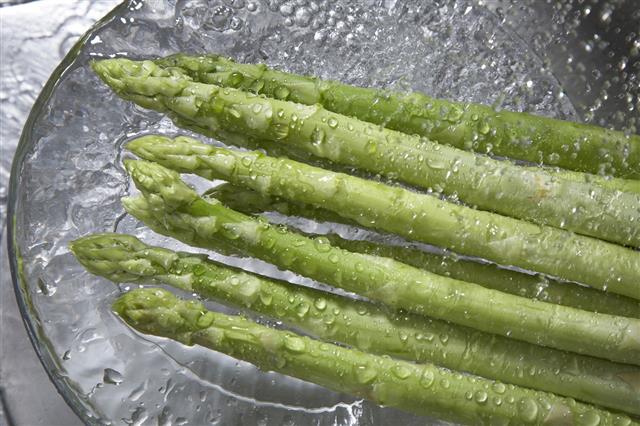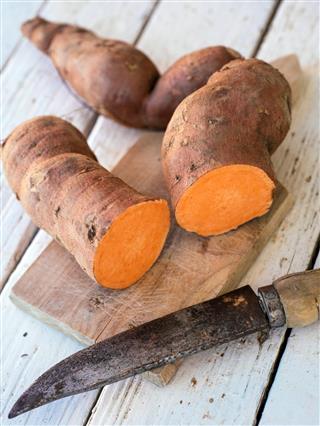
Soluble fiber refers to a type of dietary fiber which dissolves in water to form a gel like substance. It helps in lowering the bad cholesterol, keeps the digestive system healthy and controls the blood sugar levels as well. Cereals, legumes, and a number of fruits and vegetables are good sources of soluble fiber.
Dietary fiber, also known as roughage is an essential part of the diet. Found naturally in plant foods like fruits, vegetables, grains and beans, dietary fiber is not broken down in the stomach. Instead, it passes out of the system undigested. It keeps the digestive system in perfect working order, and stabilizes glucose and cholesterol levels.
According to the Academy of Nutrition and Dietetics, the intake of fiber for a healthy adult should be 20 to 35 grams per day. Unfortunately the daily intake of fiber by an Average American is restricted to 12 to 18 grams. To increase fiber intake, it is essential to know more about different types of dietary fibers and fiber-rich foods. Dietary fibers are classified as soluble and insoluble. Here is an overview of soluble fiber, along with a list of foods rich in it.
What is Soluble Fiber
Soluble fiber dissolves in water to form a gel-like substance, which is then fermented in the colon. The components of soluble fiber are gum, mucilage and pectin. It delays the gastric emptying time, gives a feeling of fullness, and reduces the absorption of calories. This in turn helps in weight control. Soluble fiber also benefits insulin sensitivity as the sugar is now released, and absorbed more slowly. It binds with the fatty acids, and is thus beneficial for lowering bad cholesterol and reducing the chances of heart diseases.
Other benefits of soluble fiber include:
- Increased gastric and pancreatic secretions to help digestion
- An increase in stool weight
- Decreased fats in the blood
- Increased production of short-chain fatty acids that act as fuel for intestinal cells
- Increase in beneficial intestinal bacteria
- Prevention of gallstones due to increase in soluble bile
Soluble dietary fiber is present in a number of foods in varying quantities. Given below is a list of plant foods rich in these fibers.
Cereals and Whole Grains
Cereals and whole grains like oats bran and oat flakes are very good sources of soluble fiber. One tablespoon of psyllium seeds (ground) provides nearly four to five grams of soluble fiber. Other cereals and grains that contain soluble fiber include:
| Cereals | Portion Size | Total Fiber (g) | Soluble Fiber (g) |
| Pysllium husk | 10g | 8.0 | 7.0 |
| Oat Bran (cooked) | ¾ cup | 4.0 | 2.2 |
| Oat flakes | 1 cup | 3.1 | 1.5 |
| All Bran | ½ cup | 8.6 | 1.4 |
| Dry Oatmeal | ½ cup | 2.7 | 1.4 |
| Rye Bread | 1 slice | 2.7 | 1.4 |
| Brown Rice (cooked) | ½ cup | 1.3 | 1.3 |
| Rolled oats (cooked) | ¾ cup | 3.0 | 1.3 |
Legumes, Nuts and Seeds
Legumes, nuts and seeds are all very high in soluble as well as overall dietary fiber. Apart from the water-soluble fiber, legumes are also a rich source of proteins, minerals and vitamins. Most of the legumes need to be soaked overnight, or for a minimum of six hours before they can be cooked. Kidney beans, black beans and navy beans are some legumes containing high levels of soluble fiber.
| Legumes and Seeds | Portion Size | Total Fiber (g) | Soluble Fiber (g) |
| Black Beans | ½ cup | 6.1 | 2.4 |
| Navy Beans | ½ cup | 6.5 | 2.2 |
| Kidney Beans | ½ cup | 7.9 | 2.0 |
| Pinto Beans | ½ cup | 6.1 | 1.4 |
| Dried Chickpeas | ½ cup | 4.3 | 1.3 |
| Flaxseeds | 1 tbsp | 3.3 | 1.1 |
Fruits and Vegetables
Apples, bananas, prunes and citrus fruits like oranges contain high levels of soluble fiber. Vegetables like Brussels sprouts, green leafy vegetables and sweet potatoes contain high levels of soluble fiber. The vegetables and fruits also contain vitamins, minerals and phytosterols, which have been known to lower the cholesterol levels. It is important to note that whole fruits (with skin and membranes) contain more fiber than fruit juices.
| Fruits | Portion Size | Total Fiber (g) | Soluble Fiber (g) |
| Apple | 1 small | 3.9 | 2.3 |
| Apricots (with skin) | 4 | 3.5 | 1.8 |
| Orange (only flesh) | 1 small | 2.9 | 1.8 |
| Fresh Mango | ½ small | 2.9 | 1.7 |
| Dried Figs | 1 ½ | 3.0 | 1.4 |
| Pear (with skin) | ½ large | 2.9 | 1.1 |
| Fresh Strawberry | 1 ¼ cup | 2.8 | 1.1 |
| Plums | 2.4 | 2.4 | 1.1 |
| Fresh Grapefruit | ½ medium | 1.6 | 1.1 |
| Vegetables | Portion Size | Total Fiber (g) | Soluble Fiber (g) |
| Brussels sprouts | ½ cup | 3.8 | 2.0 |
| Sweet Potato (only flesh) | ½ cup | 4.0 | 1.8 |
| Turnip | ½ cup | 4.8 | 1.7 |
| Asparagus | ½ cup | 2.8 | 1.7 |
| Green Peas (frozen) | ½ cup | 4.3 | 1.3 |
| Broccoli | ½ cup | 2.4 | 1.2 |
| Summer Squash | ½ cup | 2.3 | 1.1 |
| Carrots, sliced | ½ cup | 2.0 | 1.1 |
A low intake of soluble fiber increases the risk of diabetes, high blood pressure, coronary heart disease, and obesity. It can lead to health problems like hemorrhoids, colon cancer, constipation and irritable bowel syndrome. While it is important to include soluble fiber in the diet, a gradual increase is often recommended. This is because, a sudden inclusion of excess fiber in the diet can lead to side effects like abdominal bloating, cramping and diarrhea. Supplement the fiber-rich foods with a minimum of 10 cups or 6 glasses (1.5 liters) of water a day. Along with soluble fiber-rich foods, you can also opt for food supplements, available over-the-counter in the pharmacies.
Disclaimer: This NutriNeat article is solely for informative purposes, and should not be used as a substitute for professional medical advice.
















